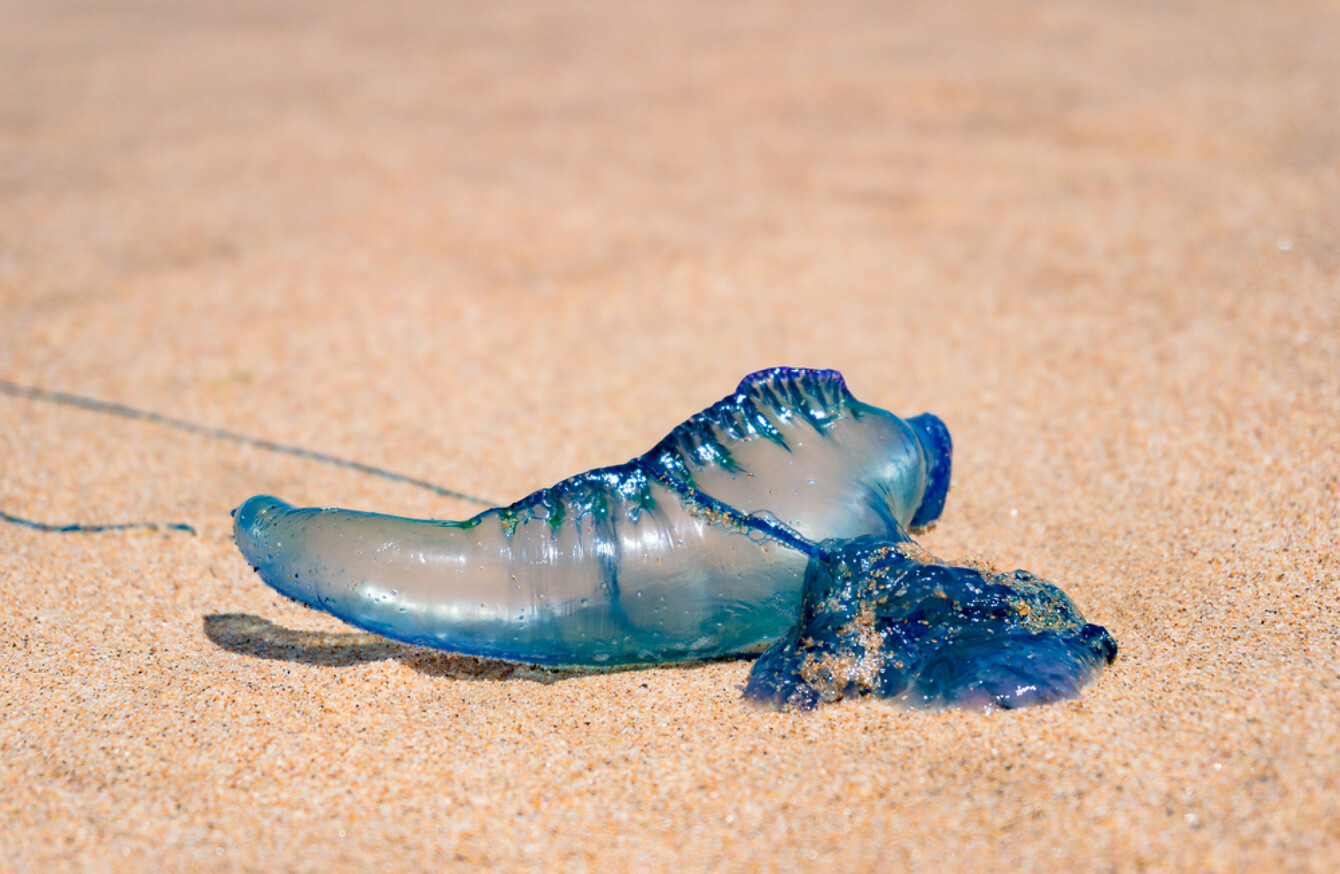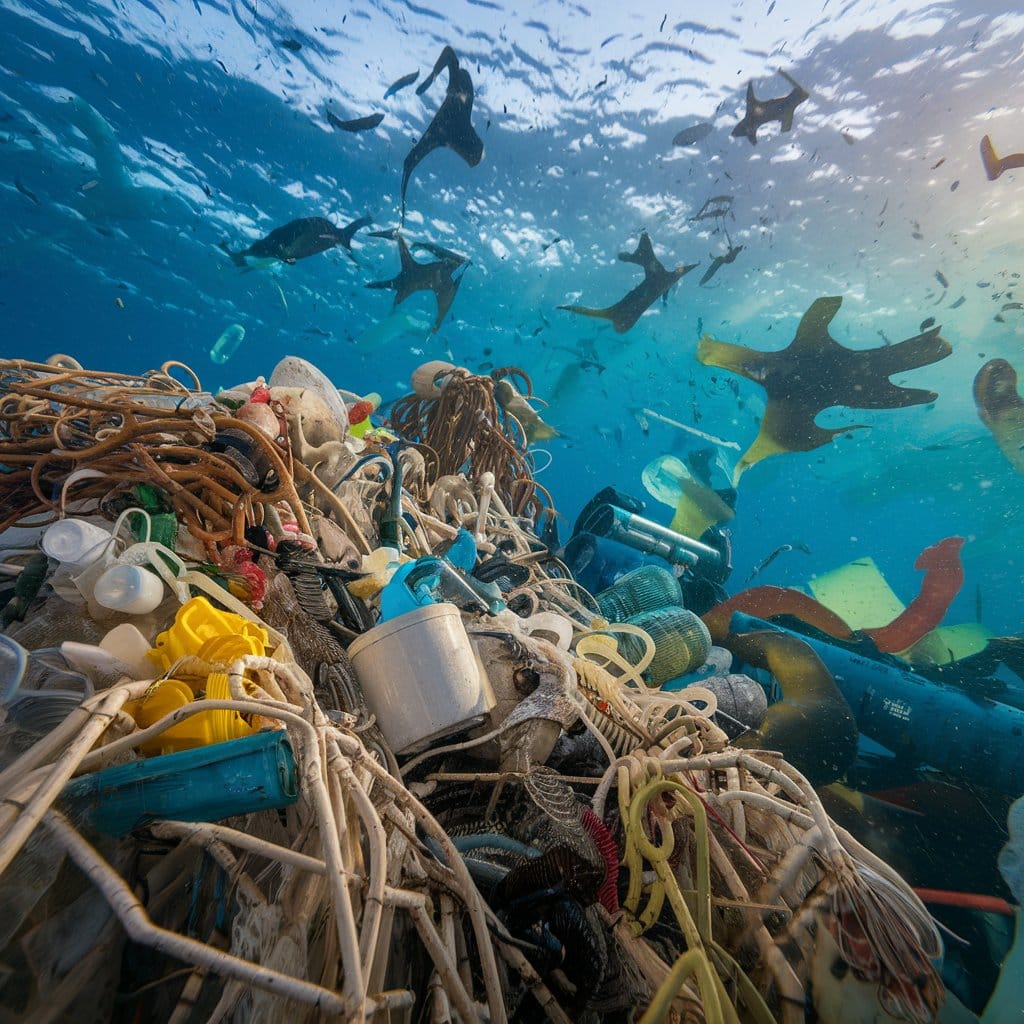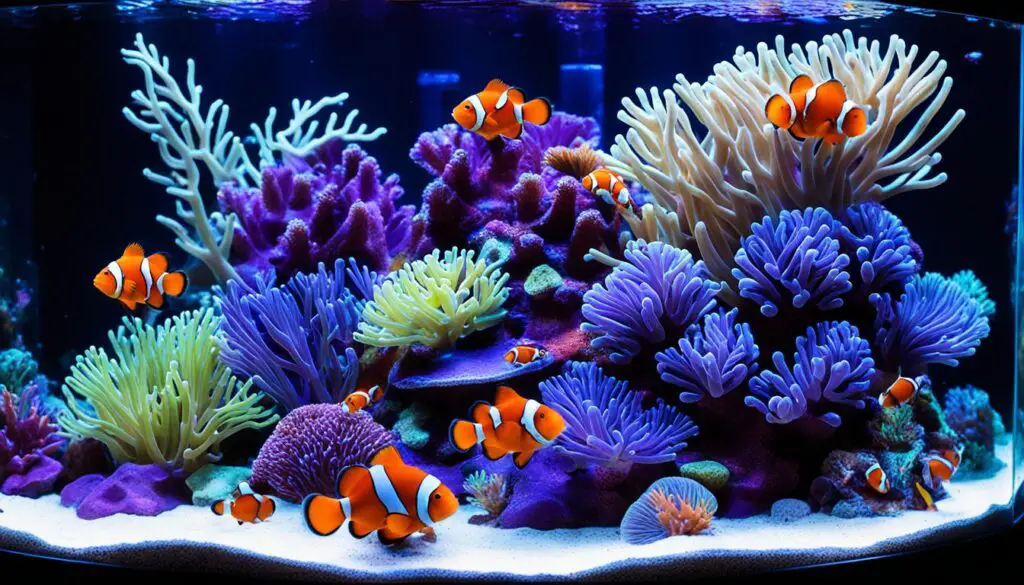What Is A Blue Bottle Jellyfish

Introduction
What Is A Blue Bottle Jellyfish: A Blue Bottle Jellyfish, scientifically known as Physalia physalis but often referred to as Portuguese Man o’ War, is a captivating marine organism that inhabits the open waters of the world’s oceans. Despite its resemblance to a single jellyfish, the Blue Bottle is a colonial organism, a colony of specialized individuals or zooids working in harmony to function as a cohesive unit. This remarkable creature derives its name from its characteristic appearance—an air-filled, bladder-like float that sits atop the water, resembling a vivid blue or violet bottle.
The Blue Bottle Jellyfish is a testament to nature’s intricate design and cooperation. Its float, or pneumatophore, provides buoyancy and helps the organism move through the ocean’s currents, while beneath it hangs a cluster of long, tentacle-like appendages. These tentacles, often measuring up to 30 feet (9 meters) or more, are equipped with stinging cells called nematocysts, allowing the colony to capture prey and defend against predators.
This introduction will delve deeper into the Blue Bottle Jellyfish, exploring its unique characteristics, habitat, feeding mechanisms, and interactions with the environment. We will uncover the beauty and complexity of this fascinating marine creature, shedding light on its impact on marine ecosystems and its significance in the world of marine biology.

What is a Blue Bottle Jellyfish?
A Blue Bottle Jellyfish, also known as the Portuguese Man o’ War, is a marine creature that resembles a jellyfish but is actually a colonial organism made up of several specialized individuals called zooids or polyps.
A Blue Bottle Jellyfish, scientifically known as Physalia physalis, is a striking marine creature often mistaken for a single jellyfish but is, in fact, a colonial organism. It derives its common name from its characteristic gas-filled float, resembling a blue or violet-hued balloon, which sits above the water surface. The float, called a pneumatophore, acts as a sail, allowing the organism to move with the wind and ocean currents.
Beneath the float dangle long tentacles, typically ranging from 10 to 30 feet (3 to 9 meters) in length, armed with specialized stinging cells called nematocysts. These tentacles serve both for capturing prey and defending against potential predators. Despite its jellyfish-like appearance, the Blue Bottle is a colonial organism made up of multiple specialized individuals, known as zooids or polyps, each with a specific function for survival and reproduction.
Blue Bottle Jellyfish are primarily found in the Atlantic, Indian, and Pacific Oceans, floating on the ocean’s surface. Their stings can cause pain, skin irritation, and allergic reactions in humans, making them a potential hazard. It’s important to exercise caution and proper first aid when encountering these fascinating yet potentially dangerous marine organisms. Understanding their biology and behavior is vital for coexisting safely with these intriguing creatures of the sea.
What does a Blue Bottle Jellyfish look like?
A Blue Bottle Jellyfish has a distinctive appearance characterized by a gas-filled float that sits above the water, resembling a blue or violet-hued balloon. Beneath the float, long tentacles trail in the water, stinging cells used for capturing prey.
A Blue Bottle Jellyfish, also known as the Portuguese Man o’ War, boasts a distinctive and mesmerizing appearance. Resembling a drifting sailboat, this marine creature is characterized by a gas-filled float, known as a pneumatophore, which sits above the water’s surface. The float typically has a striking blue or violet coloration, although it can vary in hue. Its appearance often resembles a translucent, inflated balloon, giving it an otherworldly aesthetic.
Dangling from the float are long, tentacle-like appendages that can extend up to 30 feet (9 meters) or more. These tentacles are the jellyfish’s primary means of capturing prey, and they contain specialized stinging cells called nematocysts. The tentacles are used for both hunting and defense against potential threats. The stinging cells release toxins upon contact, aiding in capturing prey and deterring predators.
While the Blue Bottle Jellyfish might resemble a single organism, it is, in fact, a colonial organism made up of multiple specialized individuals, or zooids, each with a specific function. The float contains gas-filled chambers to maintain buoyancy, while other zooids within the colony fulfill functions such as reproduction and feeding. The overall appearance of the Blue Bottle Jellyfish is an extraordinary display of adaptation to oceanic life, showcasing a delicate balance of form and function in the marine world.
Are blue bottle jellyfish harmful?
The bluebottle uses its tentacles to catch, sting, and kill its prey. The venom it uses is a mix of phenols and proteins that are deadly to their prey, but not to humans. Immediately after you get stung by a bluebottle, you will feel an intense jolt of pain.
Blue Bottle Jellyfish, also known as Portuguese Man o’ War, can be harmful to humans. Their tentacles are equipped with specialized stinging cells called nematocysts, designed for capturing prey and defending against potential threats. When these tentacles come into contact with human skin, they release toxins that can cause painful stings and skin irritation. The severity of the sting can vary based on factors like the individual’s sensitivity, the amount of contact, and the specific species of the jellyfish.
The sting of a Blue Bottle Jellyfish typically results in immediate pain, redness, and swelling in the affected area. In some cases, the sting can cause more severe allergic reactions, including difficulty breathing, nausea, muscle cramps, and in rare cases, it may lead to anaphylactic shock, which requires immediate medical attention.
If stung by a Blue Bottle Jellyfish, it’s crucial to treat the affected area promptly. First, rinse the sting site with seawater to remove any tentacles. It’s important not to use freshwater or rub the area, as it can trigger more venom release. Applying hot water (not scalding) to the sting site can help alleviate pain. Seeking medical attention is advised, especially for severe stings or if the individual shows signs of a severe allergic reaction.
Understanding the potential harm of Blue Bottle Jellyfish and adopting appropriate precautions can help mitigate the risks associated with encountering these marine organisms.
What happens if you step on a blue bottle jellyfish?
A sting from a bluebottle causes an immediate sharp pain and acute inflammatory skin reaction, which has a linear appearance (Figure 1). The pain is worsened if the tentacles are moved or the area rubbed. The intense pain can last from minutes to many hours, and can be followed by a dull ache involving the joints.
Stepping on a Blue Bottle Jellyfish, also known as a Portuguese Man o’ War, can lead to a painful and potentially dangerous encounter. The tentacles of the Blue Bottle Jellyfish contain specialized stinging cells called nematocysts, which are designed to capture prey and defend against threats. When pressure is applied to the tentacles, such as when stepping on them, these stinging cells release toxins, causing a painful sting.
The sting from a Blue Bottle Jellyfish can cause immediate pain, redness, and swelling at the site of contact. It can also lead to skin irritation and, in some cases, severe allergic reactions. The severity of the sting can vary based on the individual’s sensitivity, the amount of contact with the tentacles, and the species of the jellyfish.
If you accidentally step on a Blue Bottle Jellyfish, it’s essential to take immediate action. Rinse the affected area with seawater to remove any tentacles without rubbing or scraping the skin, as this can worsen the sting. It’s crucial to avoid using freshwater or vinegar, as these can trigger more nematocyst discharge. Applying hot water (not scalding) to the sting site may help alleviate pain. Seeking medical attention is advised, especially if the sting is severe or if you experience difficulty breathing, nausea, muscle cramps, or other concerning symptoms.
Preventing contact with Blue Bottle Jellyfish by watching out for their presence in the water and being cautious while swimming or walking along the beach is the best approach to avoid such stings.
Are blue bottle jellyfish alive?
The float is a bottle or pear-shaped sac that can exceed 15 cm. It is mainly blue, though its upper margin may show delicate shades of green or pink. It is a living, muscular bag that secretes its own gas, which is similar to air.
Blue Bottle Jellyfish, also known as Portuguese Man o’ War, are indeed alive, but they are not a single organism like conventional jellyfish. Rather, they are a colonial organism composed of multiple specialized individuals, known as zooids or polyps, working together in a highly organized and coordinated manner to survive and reproduce.
The main visible part of the Blue Bottle Jellyfish is the gas-filled float, known as the pneumatophore, which sits above the water surface and aids in its buoyancy and movement. This float is made up of a colony of specialized zooids, each with a specific function. Some zooids are responsible for reproduction, while others handle feeding and defense.
The tentacles, which trail beneath the float, are another set of zooids specialized for capturing prey and defense. These tentacles are equipped with stinging cells called nematocysts, allowing the colony to subdue and capture small fish and plankton for nutrition.
The collective behavior and functioning of these specialized zooids within the Blue Bottle Jellyfish represent the definition of a living organism. While each zooid is specialized for a particular task, they work together in a coordinated and interconnected way, exemplifying a remarkable display of nature’s ability to organize and adapt for survival in the marine environment.
Do blue bottle jellyfish sting when dead?
Avoid swimming when bluebottles have been washed onto the beach as they are likely to still be in the ocean. The tentacles frequently break off in rough water and can sting. Do not touch dead animals as the venom remains active, and nematocysts can still fire long after the animals are dead and dried.
Blue Bottle Jellyfish, also known as Portuguese Man o’ War, can still sting even when they are dead or washed up on the beach. The stinging cells, called nematocysts, are specialized structures located on the tentacles. Even after the jellyfish dies, these nematocysts remain active and capable of releasing toxins if they come into contact with skin.
When a Blue Bottle Jellyfish washes ashore or is stranded, the tentacles can still retain their stinging properties for a significant period, depending on various factors such as environmental conditions and the specific state of the jellyfish. The stinging cells can cause skin irritation, redness, and discomfort if they come into contact with human skin.
It’s important to exercise caution and avoid touching or stepping on a Blue Bottle Jellyfish, whether it’s alive or dead. If you or someone else comes into contact with a dead Blue Bottle Jellyfish and experiences a sting, it’s essential to follow appropriate first aid measures. Rinse the affected area with seawater, not freshwater, to remove any tentacles or nematocysts. Applying hot water (not scalding) can help alleviate pain from the sting. Seeking medical attention may be necessary, especially if the sting is severe or if signs of an allergic reaction develop.
Understanding the potential risk of stings from both live and dead Blue Bottle Jellyfish is crucial to ensure safety and minimize discomfort during beach activities.
What do Blue Bottle Jellyfish eat?
Blue Bottle Jellyfish primarily feed on small fish and plankton. Their tentacles capture prey, and the stinging cells immobilize them. Once captured, the prey is then transported to the feeding polyps for digestion.
Blue Bottle Jellyfish, also known as Portuguese Man o’ War, primarily feed on small marine organisms such as fish and plankton. Despite its appearance resembling a single organism, the Blue Bottle Jellyfish is a colonial organism made up of multiple specialized individuals called zooids or polyps, each with a specific function. Some of these zooids are responsible for capturing and consuming prey.
The tentacles, which trail beneath the jellyfish’s float, contain stinging cells known as nematocysts. These stinging cells are used to immobilize and capture prey. When a fish or plankton comes into contact with the tentacles, the nematocysts release toxins that stun or paralyze the prey, allowing the colony to then draw the captured prey up to the feeding polyps for digestion.
The digestive zooids within the colony of a Blue Bottle Jellyfish absorb nutrients from the prey, breaking it down and converting it into energy to sustain the entire organism. The consumption of prey is crucial for the growth, maintenance, and reproductive functions of the colony.
The Blue Bottle Jellyfish’s feeding process demonstrates a fascinating adaptation for obtaining nutrition in the open ocean. It also highlights the specialized and cooperative nature of this colonial organism, showcasing a complex system of zooids working together for survival and sustenance.
How do Blue Bottle Jellyfish reproduce?
Blue Bottle Jellyfish reproduce through a complex process involving both sexual and asexual reproduction. The floating colony releases gametes into the water, where fertilization occurs. The resulting larvae grow into new colonies, each made up of specialized zooids or polyps.
Blue Bottle Jellyfish, also known as Portuguese Man o’ War, reproduce through a unique process involving both sexual and asexual reproduction. Despite its appearance as a single entity, the Blue Bottle Jellyfish is a colonial organism made up of multiple specialized individuals called zooids or polyps.
- Sexual Reproduction: Blue Bottle Jellyfish release gametes, which are reproductive cells like eggs and sperm, into the surrounding water. The male gametes fertilize the female gametes, resulting in the formation of free-swimming larvae.
- Larval Stage: The larvae develop into a colony of zooids, each with specific functions. These functions range from buoyancy regulation to feeding and reproduction.
- Colonial Growth: The larvae then grow into new colonies through a process called metamorphosis. Each colony consists of multiple zooids, and together they function as a cohesive organism.
These colonies of zooids work together in a highly coordinated manner, allowing the Blue Bottle Jellyfish to survive and reproduce in the open ocean. Some zooids are responsible for reproduction, producing the gametes needed for sexual reproduction, while others handle functions like feeding and defense.
This unique reproductive process of the Blue Bottle Jellyfish highlights the intricate biological mechanisms that allow colonial organisms to thrive in the marine environment. It also showcases the delicate balance between specialized individuals within a colony, each contributing to the overall success and continuation of the species.

Conclusion
The Blue Bottle Jellyfish, or Portuguese Man o’ War, is a marvel of nature—an organism that defies conventional understanding with its colonial structure and vibrant presence in the world’s oceans. Its striking appearance, characterized by a distinctive sail-like float and long tentacles, commands both awe and caution. Despite its allure, the Blue Bottle Jellyfish poses a potential threat to humans due to its stinging capabilities, making it essential to exercise care and awareness when encountering them.
Delving into the world of the Blue Bottle Jellyfish unravels a complex tale of specialized zooids working in harmony, each with a specific function vital to the colony’s survival. This colonial structure showcases the intricate beauty of nature, emphasizing the importance of cooperation and specialization in the realm of marine life.
Understanding the life cycle, reproductive processes, feeding mechanisms, and potential harm caused by the Blue Bottle Jellyfish provides invaluable insights into marine ecology and biology. It underscores the delicate balance of our oceans and the interdependent relationships among various marine species.
As we continue to explore and learn about marine organisms like the Blue Bottle Jellyfish, we deepen our understanding of the ocean’s wonders and contribute to the ongoing conservation efforts essential for preserving the diverse and awe-inspiring marine life that graces our planet.



